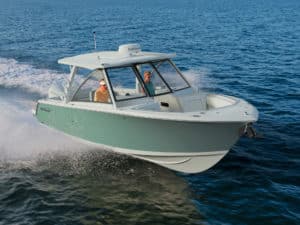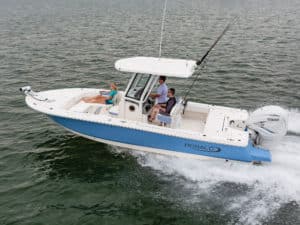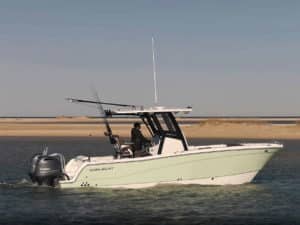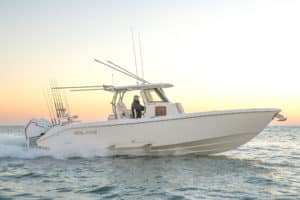I must admit that usually, a small walkaround represents my least favorite boat to run. Large people like me generally feel cramped at the helm, can’t truly fit in the berth below and have a hard time walking a fish-laden rod to the bow when necessary. I’m pleased that I experienced absolutely none of those problems on the new Trophy 2302.
Performance
I admit that testing an offshore boat on the Tennessee River takes some patience. To see how the boat handles waves, you have to wait for something big to come along pulling a large wake. Fortunately, Knoxville, Tennessee, attracts lots of tugs with barges, and when they hit a curve, those tugs throw waves off their transoms like nobody’s business. What I instantly discovered is that the significant bow flare, high freeboard and sharp entry keep the windshield and passengers dry. Also, the 20-degree deadrise, though moderate when grabbing air as you launch off a wave, makes a nice compromise when you start drift fishing. The 2302’s rolls are short and gentle.
You’ll be able to troll from here to kingdom come at 6 mph using 0.7 gph. On the other end of the spectrum, the Mercury 225 OptiMax pushed the 2302 to a top speed of 43 mph at 6,000 rpm using a modest 19.4 gph. I say modest because boats of this weight often use closer to 25 gph at top end. Though the most economical cruising speed turned out to be just over 26 mph at 4,000 rpm using 7.2 gph, I preferred running a little faster at 4,500 rpm and about 30 mph using about 9 gph.
The 2302 banks smartly into hard-over turns, bleeds speed well and carves a 180 in three boat lengths. Interestingly, turning in reverse, the Trophy responds to a change of direction instantly rather than locking into what I call “quarter steer.”
Fishing
I’m a firm believer in taking your children fishing, and you won’t find a more ideal platform for that. A surprisingly big cockpit lets kids move about, yet the gunwales are high enough to keep them safely inboard. Removable jump seats let them ride or fish without getting overtired. And if they lose interest for a few minutes, the rod holders on the splashwell provide a convenient place to set the rod until a fish piques their interest again.
You’ll find a 25-gallon recirculating livewell in the starboard corner and a walk-through transom door to port. I’d like to see a slightly higher splashwell dam for trolling down-sea, but that’s picking at nits.
It’s a bit of a stretch to reach the water’s surface, but with excellent rod storage (two in each gunwale, two on the splashwell and two more under each gunwale) you should have no problem stowing a gaff safely. Trophy adds twin 50-gallon fish boxes in the cockpit deck.
One feature I particularly appreciate is the ease with which I could move to the bow using one hand for me, and one for the boat. A comfortable padded bow seat makes bottomfishing a pleasure, and the substantial bow rail will help keep the kids safe up there, too.
Ultimately, I’d get the optional hardtop, as well. It provides four additional rod holders and a place to attach an enclosure to ward off bad weather or the cold on those glorious late-season fishing days.
Design and Construction
Trophy has come a very long way since it started building fishing boats. Today’s versions actually work well, have the proper features in the right places and even tout some innovations that other builders could take a look at. For example, the scupper system drains the cockpit so quickly that it’s almost hard to keep the deck wet enough to wash down. Below, Trophy provides even more rod storage, along with a head, a comfortable V-berth that I could stretch out on and a rudimentary galley.
Believe it or not, being a part of US Marine, Trophy has at its disposal the largest design and engineering team in the industry. The company doesn’t go overboard with advanced technology construction or ingredients, but it doesn’t shy away from using whatever will make a better product that’s still affordable, either. Affordability constitutes one of Trophy’s holy grails. For example, a skin coat of vinylester resin costs quite a bit more than straight polyester resin, but does a much better job at preventing water intrusion into the laminate, which ultimately causes blistering. Blisters make for unhappy customers, so the added expense is worth it. The company also uses Spray Core composite foam throughout the boat but only where needed. And the hulls and stringer system are completely hand-laid fiberglass, providing enough strength and durability to allow Trophy to grant a 10-year warranty.
I can’t imagine a more appropriate and affordable starter boat for a family who wants to fish nearshore and offshore than this Trophy 2302.








